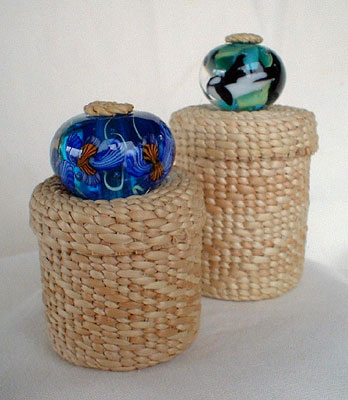Traditional Baskets

(Image courtesy of Teri Rofkar)
Basket weaving styles and methods vary between different tribes. For example, Makah baskets are famous for their representations of sea life. Haida baskets are woven upside down, whereas Tlingit baskets are woven upright, and the latter tend to use dyed grasses and other materials for decoration. The Twana used cattails, whereas the Tlingit used spruce as the main basket material. In the next section, we will look more closely at the many different types of Tlingit baskets.
Tlingit Baskets

(Image courtesy of Teri Rofkar)
Baskets have been an important part of the Tlingit culture for an untold number of generations, and play a role in Tlingit spirituality and ceremonial life. Baskets have been used for a wide variety of purposes, and they are also highly regarded as works of art (though the Tlingit have many other forms of art as well, such as woodcarving).
Baskets of different sizes were made for different purposes. Larger baskets were part of the home, while smaller ones could be carried around or worn.
Perhaps the most basic type of basket is the cylindrical container basket, used to store food, clothing, and other items in the home. Large cylindrical baskets could be cut in half and made into cradles for babies.
Before the introduction of metal pots to the Tlingit, baskets were also used to cook food. The weaving of Tlingit baskets is often fine enough so that many of them were watertight. Hot stones would be dropped into cooking baskets with food and water inside.
Other Tlingit Baskets

Flatter baskets were used as food platters. Smaller baskets were used as drinking cups, bowls for eating, or spoon holders.
Double baskets (consisting of one basket inside of another basket) were used by shamans who carried water and other materials (usually for rituals) in the two separate compartments.
Other baskets had handles or could be worn around the neck or carried on one's back, to aid in berry-picking or to hold other small items.
Baskets with open weaves were not watertight and were used for straining and draining, such as when collecting clams and seaweed, or as fish traps.
Finally, basket weaving was used to make hats worn by the Tlingit. These included everyday working hats, hats worn by upper class members of Tlingit society, ceremonial hats, and hats worn by Tlingit shamans.
Tlingit Baskets Today

After the Tlingit came in contact with Europeans and other non-Indigenous Peoples, basket-weaving became important not just for use within Tlingit society, but as items for trade or sale. As such, baskets for trading (and to sell to tourists) were made that featured greater ornamentation but were not as durable as more traditional baskets. Also, basket weavers experimented with less traditional designs such as covered bottles, baby boots, and teapots (all of which were sold to tourists and collectors). During the Great Depression, however, mainstream interest in Tlingit basketry predictably declined and the art was in danger of dying out.
Since the 1970s, however, there has been a renewed interest in native basket weaving, and Tlingit elders previously hesitant to spread their art to non-Tlingit began to teach others how to weave in the traditional way. Tlingit baskets, as well as baskets from other tribes, continue to be made, collected, and displayed with pride and respect all over the world.